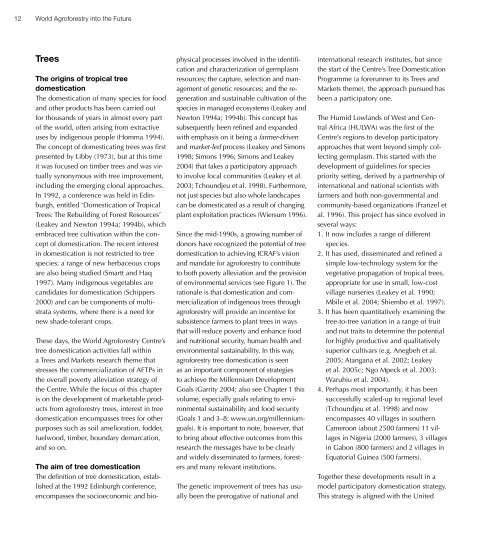The challenge of HIV/AIDS: Where does agroforestry fit in? - World ...
The challenge of HIV/AIDS: Where does agroforestry fit in? - World ...
The challenge of HIV/AIDS: Where does agroforestry fit in? - World ...
You also want an ePaper? Increase the reach of your titles
YUMPU automatically turns print PDFs into web optimized ePapers that Google loves.
12<strong>World</strong> Agr<strong>of</strong>orestry <strong>in</strong>to the FutureTrees<strong>The</strong> orig<strong>in</strong>s <strong>of</strong> tropical treedomestication<strong>The</strong> domestication <strong>of</strong> many species for foodand other products has been carried outfor thousands <strong>of</strong> years <strong>in</strong> almost every part<strong>of</strong> the world, <strong>of</strong>ten aris<strong>in</strong>g from extractiveuses by <strong>in</strong>digenous people (Homma 1994).<strong>The</strong> concept <strong>of</strong> domesticat<strong>in</strong>g trees was firstpresented by Libby (1973), but at this timeit was focused on timber trees and was virtuallysynonymous with tree improvement,<strong>in</strong>clud<strong>in</strong>g the emerg<strong>in</strong>g clonal approaches.In 1992, a conference was held <strong>in</strong> Ed<strong>in</strong>burgh,entitled ‘Domestication <strong>of</strong> TropicalTrees: <strong>The</strong> Rebuild<strong>in</strong>g <strong>of</strong> Forest Resources’(Leakey and Newton 1994a; 1994b), whichembraced tree cultivation with<strong>in</strong> the concept<strong>of</strong> domestication. <strong>The</strong> recent <strong>in</strong>terest<strong>in</strong> domestication is not restricted to treespecies; a range <strong>of</strong> new herbaceous cropsare also be<strong>in</strong>g studied (Smartt and Haq1997). Many <strong>in</strong>digenous vegetables arecandidates for domestication (Schippers2000) and can be components <strong>of</strong> multistratasystems, where there is a need fornew shade-tolerant crops.<strong>The</strong>se days, the <strong>World</strong> Agr<strong>of</strong>orestry Centre’stree domestication activities fall with<strong>in</strong>a Trees and Markets research theme thatstresses the commercialization <strong>of</strong> AFTPs <strong>in</strong>the overall poverty alleviation strategy <strong>of</strong>the Centre. While the focus <strong>of</strong> this chapteris on the development <strong>of</strong> marketable productsfrom agr<strong>of</strong>orestry trees, <strong>in</strong>terest <strong>in</strong> treedomestication encompasses trees for otherpurposes such as soil amelioration, fodder,fuelwood, timber, boundary demarcation,and so on.<strong>The</strong> aim <strong>of</strong> tree domestication<strong>The</strong> def<strong>in</strong>ition <strong>of</strong> tree domestication, establishedat the 1992 Ed<strong>in</strong>burgh conference,encompasses the socioeconomic and biophysicalprocesses <strong>in</strong>volved <strong>in</strong> the identificationand characterization <strong>of</strong> germplasmresources; the capture, selection and management<strong>of</strong> genetic resources; and the regenerationand susta<strong>in</strong>able cultivation <strong>of</strong> thespecies <strong>in</strong> managed ecosystems (Leakey andNewton 1994a; 1994b). This concept hassubsequently been ref<strong>in</strong>ed and expandedwith emphasis on it be<strong>in</strong>g a farmer-drivenand market-led process (Leakey and Simons1998; Simons 1996; Simons and Leakey2004) that takes a participatory approachto <strong>in</strong>volve local communities (Leakey et al.2003; Tchoundjeu et al. 1998). Furthermore,not just species but also whole landscapescan be domesticated as a result <strong>of</strong> chang<strong>in</strong>gplant exploitation practices (Wiersum 1996).S<strong>in</strong>ce the mid-1990s, a grow<strong>in</strong>g number <strong>of</strong>donors have recognized the potential <strong>of</strong> treedomestication to achiev<strong>in</strong>g ICRAF’s visionand mandate for agr<strong>of</strong>orestry to contributeto both poverty alleviation and the provision<strong>of</strong> environmental services (see Figure 1). <strong>The</strong>rationale is that domestication and commercialization<strong>of</strong> <strong>in</strong>digenous trees throughagr<strong>of</strong>orestry will provide an <strong>in</strong>centive forsubsistence farmers to plant trees <strong>in</strong> waysthat will reduce poverty and enhance foodand nutritional security, human health andenvironmental susta<strong>in</strong>ability. In this way,agr<strong>of</strong>orestry tree domestication is seenas an important component <strong>of</strong> strategiesto achieve the Millennium DevelopmentGoals (Garrity 2004; also see Chapter 1 thisvolume, especially goals relat<strong>in</strong>g to environmentalsusta<strong>in</strong>ability and food security(Goals 1 and 3–8: www.un.org/millenniumgoals).It is important to note, however, thatto br<strong>in</strong>g about effective outcomes from thisresearch the messages have to be clearlyand widely dissem<strong>in</strong>ated to farmers, forestersand many relevant <strong>in</strong>stitutions.<strong>The</strong> genetic improvement <strong>of</strong> trees has usuallybeen the prerogative <strong>of</strong> national and<strong>in</strong>ternational research <strong>in</strong>stitutes, but s<strong>in</strong>cethe start <strong>of</strong> the Centre’s Tree DomesticationProgramme (a forerunner to its Trees andMarkets theme), the approach pursued hasbeen a participatory one.<strong>The</strong> Humid Lowlands <strong>of</strong> West and CentralAfrica (HULWA) was the first <strong>of</strong> theCentre’s regions to develop participatoryapproaches that went beyond simply collect<strong>in</strong>ggermplasm. This started with thedevelopment <strong>of</strong> guidel<strong>in</strong>es for speciespriority sett<strong>in</strong>g, derived by a partnership <strong>of</strong><strong>in</strong>ternational and national scientists withfarmers and both non-governmental andcommunity-based organizations (Franzel etal. 1996). This project has s<strong>in</strong>ce evolved <strong>in</strong>several ways:1. It now <strong>in</strong>cludes a range <strong>of</strong> differentspecies.2. It has used, dissem<strong>in</strong>ated and ref<strong>in</strong>ed asimple low-technology system for thevegetative propagation <strong>of</strong> tropical trees,appropriate for use <strong>in</strong> small, low-costvillage nurseries (Leakey et al. 1990;Mbile et al. 2004; Shiembo et al. 1997).3. It has been quantitatively exam<strong>in</strong><strong>in</strong>g thetree-to-tree variation <strong>in</strong> a range <strong>of</strong> fruitand nut traits to determ<strong>in</strong>e the potentialfor highly productive and qualitativelysuperior cultivars (e.g. Anegbeh et al.2005; Atangana et al. 2002; Leakeyet al. 2005c; Ngo Mpeck et al. 2003;Waruhiu et al. 2004).4. Perhaps most importantly, it has beensuccessfully scaled-up to regional level(Tchoundjeu et al. 1998) and nowencompasses 40 villages <strong>in</strong> southernCameroon (about 2500 farmers) 11 villages<strong>in</strong> Nigeria (2000 farmers), 3 villages<strong>in</strong> Gabon (800 farmers) and 2 villages <strong>in</strong>Equatorial Gu<strong>in</strong>ea (500 farmers).Together these developments result <strong>in</strong> amodel participatory domestication strategy.This strategy is aligned with the United




![MNC_00_Modau [Compatibility Mode].pdf](https://img.yumpu.com/51432208/1/190x146/mnc-00-modau-compatibility-modepdf.jpg?quality=85)











